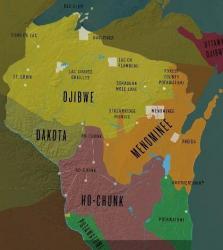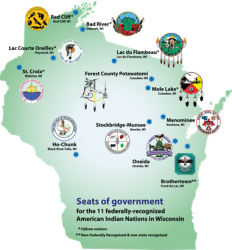
LWVWI Community Alliances Committee
Land Acknowledgement Guidance Document


https://wisconsinfirstnations.org/map/
Introduction -
Land acknowledgements have been used by Native Peoples and more recently non-Native people to recognize Indigenous Peoples who are the original stewards of the lands on which we now live. This historical, cultural, and spiritual context is important to know. The League of Women Voters of Wisconsin Community Alliances Committee (CAC) has developed this guidance document to assist local Leagues in deciding whether and how to include these statements in their programming. As we speak the land acknowledgment in our hearts and minds, we must remember to speak intentionally as allies.
History of Land Acknowledgements –
Land acknowledgments are derived from a historic tradition held in high regard between sovereign tribal nations, pre-contact to the present. There are "Edge of the Forest" ceremonies in which warrior societies escort delegations into a host tribal community, and the visitors would respectfully acknowledge the territory of which they were entering so the hosts could also extend goodwill and hospitality. This was not only polite protocol, but a way to reassure the chiefs and other leaders of the visitor's good intentions.
Reasons for Land Acknowledgements -
In order to do a proper and respectful land acknowledgement, it is important for Leagues to ask themselves why they are doing this. Is it because everyone else is? Is it out of personal or organizational guilt? Or is it because your local League is committed to serving the Indigenous community in ways that they believe are most helpful. Making a land acknowledgment should be motivated by genuine respect and support for Native Peoples and a genuine interest in knowing more.
Composing a Land Acknowledgement –
When composing a land acknowledgement, it is important to remember that land acknowledgements do not exist in a past tense, or historical context: colonialism is a current ongoing process that needs to be recognized. Remember, Indigenous people are still here and they are thriving and we need to acknowledge those elements that are alive and being nourished while at the same time acknowledging the trauma of the past and the survival of the present and future.
It is also important to pair any land acknowledgement with a commitment to action. Are we as a League leaving Indigenous people in a stronger, more empowered place because of this land acknowledgment and how does our local League plan to take action to support Indigenous communities and to right historical wrongs? In order to do this properly and respectfully, it is important for the local League to understand the history and needs of the Indigenous communities. While it is important to be historically accurate, it is also important to honor the tribes that are current stewards of the land and let them know that we as an organization see them now at the same time that we are also acknowledging the history of colonialism, genocide and trauma that was inflicted on Indigenous communities.
Examples of needs of Indigenous communities may include environmental issues, clean water, democracy challenges including but not limited to voter suppression, treaty rights, violence against women and many others. The people composing the land acknowledgement should find out what issues are important to the local Indigenous communities in order to complete this part.
When to do a Land Acknowledgement –
Do land acknowledgements need to be done at every meeting that a state or local League conducts? Probably not, in part to not minimize or make rote the meaning and purpose of the land acknowledgement. However, public programs including annual meetings such as issues briefing and business meetings, remembrances, celebrations and candidate forums or debates are very appropriate times to be doing a land acknowledgement. These events offer us a chance to publicly affirm our commitment to indigenous communities and call for action. The purpose or meaning of the event can help decide whether a land acknowledgement is appropriate, what should be included and what the call to action is.
Who Should do the Land Acknowledgement –
There are differing opinions on this question. One thought is that any land acknowledgement should be done by a tribal person because it means more to citizens of the sovereign nations. More attention and respect will be paid to the words of that person because they will be known to be thoughtful and purposeful. If the speaker is non-tribal, the land acknowledgement may well be delivered with thoughtfulness and good intent, but it is difficult for some Native people to ignore its reductive nature and shift in historical context when delivered from the class of advantage. And land acknowledgments are about the history of both.
Another thought is that the land acknowledgement should be done by a non-tribal person as it is not up to the Indigenous community to continually educate the non-Indigenous community about the history and needs of tribal people. This school of thought believes that the acknowledgement of the wrongs and of the need for change means more coming from the people who have to make the changes.
Working with Indigenous Communities –Because of both US and League history, trust may need to be nurtured with local tribal communities. This can be done by showing up at events, supporting initiatives and learning about the needs of local Indigenous communities. Trust will not happen quickly and Leagues will need to be patient and not expect it to be easily earned. One idea is to identify Native elders and culture bearers in your region to join in a conversation about how they would like to see the land acknowledgement practice take shape locally, particularly how it could be of greatest benefit for their communities. Consider offering an honorarium to those who take part in the dialogue. This dialogue could also be a public forum, engaging others who want to learn about land acknowledgements. Or you could share a video, transcript, or other reporting to inform and engage the wider community.
Key Points to Consider – Composing Land Acknowledgements
-
Acknowledge the Indigenous Nations who once inhabited or lived on the land as well as those who currently inhabit the land. For example, the region currently occupied by the Anishinaabeg are, in fact, the homelands of the Dakota and there is adequate evidence of other nations such as the Huron.
-
Briefly refer to tribal history and how the land shapes personal identity. Include how they describe themselves, i.e. The Menominee Nation are the “People of the Wild Rice”.
-
Call for understanding of the effects of colonialism, broken treaties and theft of their land.
-
Propose advocacy/action on specific issues affecting the Indigenous Nations. The program should guide the wording.
Samples of Land Acknowledgements
While templates are of great assistance – each land acknowledgement should be specific to the event and include action to be taken.
SAMPLE #1
-
“Every community owes its existence and vitality to generations from around the world who contributed their hopes, dreams, and energy to making the history that led to this moment. Some were brought here against their will, some were drawn to leave their distant homes in hope of a better life, some have lived on this land for more generations than can be counted. Truth and acknowledgement are critical to building mutual respect and connections across all barriers of heritage and difference. We begin this effort to acknowledge what has been buried by honoring the truth. We are standing on the stolen ancestral lands of the _____________ People. (Include some of the history and culture). We pay respects to their elders past, present and future. Please take a moment to consider the many legacies of violence, displacement, migration, and settlement that brings us together today. And please join us in uncovering such truths at any and all public events.” (Adapted from the “Honor Native Land Guide" , https://www.usdac.us/nativeland)
SAMPLES #2 & #3
-
“This is the land of __________________ and this is what we are going to do to breathe life into our obligations to those communities and those treaties.”
-
“We are on the Territory of the _______________ and here is what it compels us to do.”
(SOURCE: Interview, CBC radio program, UNRESERVED, last updated June 19, 2019, titled “I Regret It- Hayden King on Writing Ryerson University’s Territorial Acknowledgement”; Hayden King, Anishinaabe and a professor at Ryerson University)
SAMPLE #4 – regarding acknowledging the original inhabitants of the land
-
_______ "to be the original homelands of the Dakota of which the Anishinaabeg now occupy and care for." (Red Nation Podcast, August 30, 2021.)
For More Information
https://www.menominee-nsn.gov/CulturePages/BriefHistory.aspx
https://www.usdac.us/nativeland
www.northwestern.edu/native-american-and-indigenous-peoples/about/Land%2...
https://nativegov.org/news/beyond-land-acknowledgment-guide/
https://americanindian.si.edu/nk360
LWVWI Community Alliances Committee Creative Team:
Renee Gralewicz – LWV Appleton
Jeanne Roberts – LWV Appleton
Dee Sweet – LWV Ashland/Bayfield Counties
Anne Chartier – Ashland/Bayfield Counties
Lisa Janairo – LWV Dane County
Deb Sabol-Williams – LWV Sheboygan County